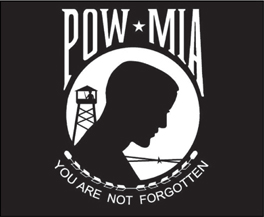
Of the many contentious issues left unsettled at the conclusion of the Vietnam War, the most traumatic and emotional was the fate of American servicemen officially labeled “missing in action”—the MIAs. Even the number of MIAs at the end of the war—twenty-five hundred—is in dispute. One of the agreements in the 1973 Paris Peace Accords provided for the return of all U.S. POWs and assistance regarding MIAs.

Created in 1971 by the National League of Families of American Prisoners and Missing in Southeast Asia, this flag serves as a constant reminder of the plight of America’s POWs/MIAs.
The political debate on whether North Vietnam—later Vietnam—had returned all American prisoners or were secretly keeping some was a recurrent political flashpoint. In 1979, under pressure from the National League of Families of American Prisoners and Missing in Southeast Asia and other organizations, Congress officially changed the classification of status of soldiers listed as “killed in action” (KIA) but whose remains had not been recovered back to POW/MIA. This allowed family members to receive higher government benefits as well as restoring the hope that missing troops might still be alive. President Reagan in 1982 stated that he believed some Americans were still being held against their will in Southeast Asia, and directed that the POW/MIA flag be flown over the White House one day per year. By 1990 all fifty states had an official National POW/MIA Recognition Day. The subject of MIAs was also a topic in the U.S. presidential election in 1992. Presidential candidate Ross Perot stated that he believed there were some Americans still being held prisoner.
In 1992 an international Joint Task Force-Full Accounting (JTF-FA) was created to determine the fate of the MIAs. The JTF-FA organizes teams of searchers in cooperation with the host country (Vietnam, Laos, or Cambodia) to search the suspected sites where the remains of American servicemen may be. Colonel Robert Gahagan served as the commander of one JTF-FA team for two years in Laos, and reported that all the teams are in a race against time. “Family members of our missing servicemen are aging,” he said. “[Local] witnesses . . . are aging too. . . . And . . . in Laos, because of the soil conditions, human remains and physical evidence deteriorate very rapidly.”
Even without a war, the search for remains is dangerous. On April 7, 2001, a helicopter carrying sixteen members of an MIA search team crashed into a mountainside due to heavy fog south of Hanoi. Seven Americans died in that crash—the first loss of life in the joint recovery program.